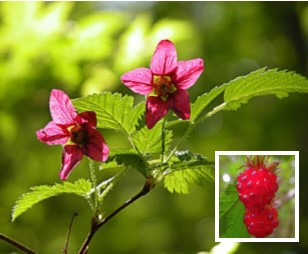You have been learning about some of the native plants that live here at St. Andrew. Remember that all of these plants, the animals that benefit from them, and even you are made of the same stuff. We are all connected, and when nature is allowed to work in the way it is meant to work, it’s a great system.
I’m going to introduce you to a plant that is a cousin to marionberries, loganberries, and boysenberries. When you come down the path from the parking lot, you will see the scouring rush here. Just past that, you will see a stairway down to another path. Follow me down there to the plant I want to show you.

This is a salmonberry. It doesn’t look much like a salmon, but more about that later. This plant can grow to be about 4 meters high. This is about a meter, so this plant can be as big as four of these. You will notice that this plant has sticky thorns. That is one way that we know that the salmonberry is related to roses. Also look at the 3-part leaves, which don’t have thorns. This is one exception to the “leaves of three, let it be” rule.
Its full name is Rubus spectabilis. Rubus comes from a Latin word that means “red.” This plant isn’t red, but its flowers and berries are. Spectabilis means “spectacular,” and the salmonberry’s flowers and berries certainly are. The common name might come from this red color, which is similar to the color of salmon. It might also come from how the indigenous Kalapuya people, who lived right here, used to eat the berries with salmon or salmon roe, otherwise known as caviar. They also ate the small shoots, so this was an important source of food. The natives also used the bark from the stems to make a medicine that was especially good for treating burns.
The berries on this plant are among the first to ripen. Unlike most berries, they are full of fat, which helps the birds live through parts of the year when food is scarce.

You have been hearing about pollinators. This plant is loved by birds like hummingbirds. Other birds, like grouse, pigeons, quail, grosbeaks, jays, robins, thrushes, towhees, waxwings, and sparrows, eat the berries and the brambles. Raccoons, opossums, skunks, foxes, squirrels, chipmunks, and other rodents also love the berries. The leaves and stems are eaten by deer and rabbits, and bears and beavers eat the fruit, bark, and twigs. We know there are beavers here in our woodland because they leave behind pieces of wood that have been chewed on the ends.
Even the brambles of the salmonberry help small animals. They provide a safe place for them to hid from predators. Would you want to go into that prickly place after a small animal hiding there?
The salmonberry is a terrific plant and it is important in our efforts to restore the wetlands here. But you probably wouldn’t want it in your backyard, because it is really full of stickers. When you come down the trail to the Sanctuary of the Firs, though, stop by and say hello to the salmonberry. And remember to keep finding ways to help build our Homegrown National Park right here in our own community.
Pat Christiansen

